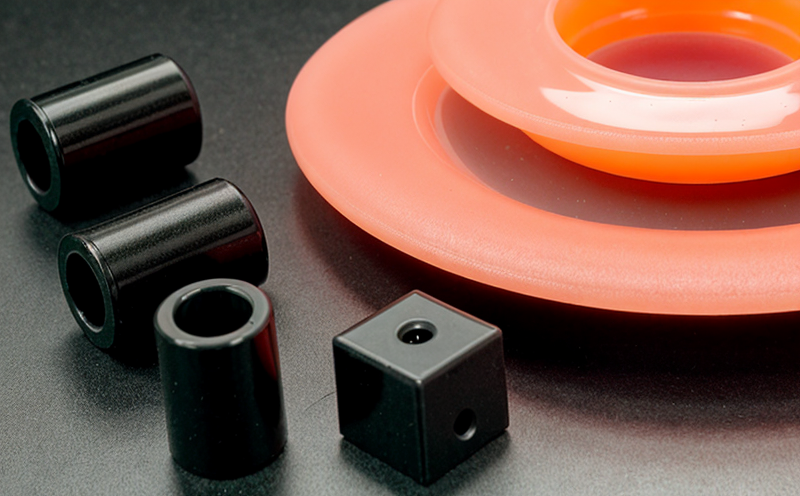ISO 899 Creep Testing of Plastic Leisure Materials
The ISO 899-1 standard provides a comprehensive approach to testing creep behavior in plastic materials. This is particularly important for sports and leisure plastics, where long-term durability under load is crucial for maintaining product performance and safety.
Creep testing evaluates how much a material deforms over time when subjected to constant stress. For leisure plastics like those used in golf club grips, ski bindings, or skateboard decks, the ability of these materials to retain their shape and strength is critical. The ISO 899-1 standard specifies test methods that simulate real-world conditions, ensuring accurate assessment.
The testing process involves placing a specimen under constant load at a defined temperature for an extended period. The deformation of the material over time is measured precisely to determine its resistance to creep. This data helps manufacturers ensure their products meet quality standards and can withstand the rigors of use without degradation.
For instance, in the case of ski bindings, the ability to maintain secure fastenings under pressure is paramount for user safety. Creep testing ensures that materials used in such components do not degrade over time, maintaining reliability throughout the product's life cycle. Similarly, golf club grips need to provide a comfortable and secure fit without deforming or losing grip over extended use.
The precision of ISO 899-1 is crucial for industries where quality can mean the difference between user satisfaction and product failure. By adhering to these standards, manufacturers can produce products that not only meet regulatory requirements but also exceed expectations in terms of durability and performance.
Compliance with ISO 899-1 offers several benefits: it ensures consistent results across different batches of materials, provides a standardized approach for comparison between products, and builds trust among consumers who value quality. The test method is particularly relevant in the sports and leisure sector where long-term performance is critical.
Real-world applications of this test include not only the aforementioned sports equipment but also components used in outdoor furniture, which must withstand weathering and stress over time. By rigorously testing materials for creep resistance, manufacturers can ensure their products remain functional and safe under varying environmental conditions.
Why Choose This Test
- Ensures Quality Compliance: ISO 899-1 provides a robust framework for testing creep behavior, ensuring compliance with international standards and regulations.
- Predicts Long-Term Performance: Creep testing helps predict how materials will perform over time under load, critical for durable products like sports equipment.
- Enhances Safety: By assessing the durability of materials used in high-stress applications, this test ensures enhanced safety and reliability for users.
- Improves Product Design: The insights gained from creep testing can inform product design improvements, leading to more robust and efficient products.
- Facilitates Industry Trust: Compliance with ISO standards builds trust among consumers and stakeholders, enhancing brand reputation.
Customer Impact and Satisfaction
The results of creep testing significantly impact customer satisfaction by ensuring the longevity and reliability of products. Consumers who purchase durable sports equipment or leisure items are more likely to be satisfied with their purchases, knowing that these products will perform consistently over time.
- Enhanced Product Lifespan: Creep testing ensures that materials used in critical components do not degrade prematurely, extending the product’s useful life.
- Better Safety Assurance: Products tested for creep behavior are safer to use, reducing the risk of failure under stress.
- Informed Decision-Making: Customers can make informed choices about their purchases based on reliable test data, leading to higher customer satisfaction.
The importance of this testing cannot be overstated. It directly affects user experience and trust in the brand. Products that meet or exceed these standards are more likely to retain customers and gain positive reviews, contributing to overall brand loyalty.
Competitive Advantage and Market Impact
The competitive landscape of sports and leisure products is highly dynamic, with constant innovation and evolving consumer expectations. Compliance with ISO standards like ISO 899-1 provides a clear advantage by ensuring that products meet rigorous quality benchmarks.
By incorporating creep testing into their product development processes, manufacturers can differentiate themselves in the market. Consumers are increasingly inclined towards brands that demonstrate a commitment to high-quality materials and performance. This can lead to increased market share and customer loyalty.
Furthermore, compliance with international standards enhances regulatory compliance, reducing the risk of legal issues and ensuring smooth operations within different markets. For global businesses, this is particularly important as it streamlines processes and ensures uniform quality across all regions.
The competitive advantage gained from ISO 899-1 can also translate into cost savings in the long run by preventing costly recalls or product failures. By identifying potential issues early through comprehensive testing, companies can reduce warranty claims and improve overall operational efficiency.





